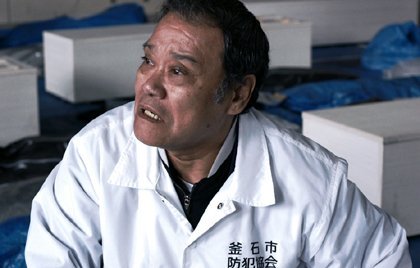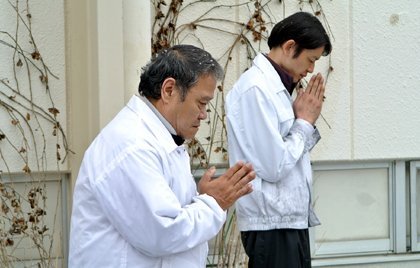Movie | "The Remains" is a lesson for us
The greatest death of a disaster lies in its uncertainty and inability to resist. If it were Hollywood blockbusters, most of them would use special effects to create a scene of a stunning tsunami moment to portray a sudden catastrophe, and then use unknown heroes to penetrate the disaster location to break through the adversity and help the victims. through shame. I believe that only Japanese creative talents will use this extraordinary technique to make a film as calm as "The Remains" (頭 身 明日 へ の 十 日间). The film is adapted from a journalist's interview with the 311 earthquake, "The Remains-The End of the Earthquake and Tsunami" (Remains Earthquake Disaster, Jinbo の 果 て に). Director Junzuka Ryoichi did not use the slightest pen and ink to narrate the post-disaster sadness scene. He only focused on the detailed story of where the body was placed. He uses his knowledge to handle corpses, using retired funeral volunteer Tsuneo Aiba (played by Toshiyuki Nishida) as the center of the narrative. There is also a genuine attitude towards the deceased, family members and staff of the deceased. His gentle and polite demeanor is the hallmark of Japanese films and these films.

From being overwhelmed to being on the right track
After the tsunami, the bodies found in the mud were sent to the school gym, where the remains of Kamaishi City are. The crematorium incinerator was damaged in the earthquake and was inoperable, and the coffin could not be dispatched immediately. The body must be left at the place where it is placed. This makes the place the main scene of the film, which also creates a sense of difficulty. City hall staff were dispatched to help with all placement arrangements, but they did not handle the large number of bodies, nor were they afraid of the harsh conditions, and they could only stand to the side of the loss. The doctor who assisted in the post mortem to identify bodies complained of the many gruesome deaths, and could only do his best to work in silence, ignoring the other staff. Because of the many deaths, the staff responsible for removing bodies did not have time to handle every body. The emergence of volunteer Aiba, based on his experience with the remains and family members, helps everyone understand the methods of handling the bodies and communicate with the families of the deceased. Although the corpse is the main narrative object in the entire film, there are few snapshots to see the remains of the deceased. This is very much in accordance with Aiba's attitude that views death as life, and respect for corpses as well. Makes a place to follow Chaos gradually becomes better able to take care of the dead, the living, and the psychological needs of the audience. based on his experience handling corpses and family members, helps everyone understand methods of handling corpses and communicates with the family of the deceased. Although the corpse is the main narrative object in the entire film, there are few snapshots to see the remains of the deceased. This is very much in accordance with Aiba's attitude that views death as life, and respect for corpses as well. Makes a place to follow Chaos gradually becomes better able to take care of the dead, the living, and the psychological needs of the audience. based on his experience handling corpses and family members, helps everyone understand methods of handling corpses and communicates with the family of the deceased. Although the corpse is the main narrative object in the entire film, there are few snapshots to see the remains of the deceased. This is very much in accordance with Aiba's attitude that views death as life, and respect for corpses as well. Makes a place to follow Chaos gradually becomes better able to take care of the dead, the living, and the psychological needs of the audience. This is very much in accordance with Aiba's attitude that views death as life, and respect for corpses as well. Makes a place to follow Chaos gradually becomes better able to take care of the dead, the living, and the psychological needs of the audience. This is very much in accordance with Aiba's attitude that views death as life, and respect for corpses as well. Makes a place to follow Chaos gradually becomes better able to take care of the dead, the living, and the psychological needs of the audience.
From handling scraps to caring for the living
Because many bodies drowned, the weight of the bodies increased and the bodies were covered in mud. The person in charge of the transport often accidentally drops the body on the ground at first, causing family members to search. their relatives to blame. Due to the panic, many of the deceased's limbs were stiff and could not be placed on the ground, so the staff forcibly broke the limbs straight. Aiba saw that he did not blame anyone, but explained to them that the deceased was unable to return to their original position due to the stiffness of their muscles. As long as they massage their muscles, the limbs will naturally drop. Aiba's caring attitude and demonstrations convinced those present. Moreover, he spoke to the people at the city hall with humility, to clean the place and cover the corpse with a neat cloth, and to speak to the corpse as if he were a living person, very carefully. Before returning home to rest, I quietly remembered the name of each deceased, hoping to call the deceased by his name. Her respect for the body not only moves the staff, but also makes family members with the mixed feelings that accompany the body feel a little uncomfortable.

The townspeople rushed to camp every day and planned all kinds of little things, often ignoring the people they cared most about. The tsunami made regret due to negligence floating in the river of life. Some lost their loved ones, some lost children, and some lost their trust. The place where the corpses rest is the place where the living can carry out their final responsibilities for the dead, talk about their hearts, or say goodbye. Aiba here functions as a communication between the living and the dead, teaching her daughter to apply make-up for her mother to cover up her changes in appearance; staying in the shelter all night, allowing the mother who lost her daughter to accompany her daughter to the last moment. All this is done not only for the dead, but also for the living. Aiba’s actions stemmed from his insights from the works of his past, when encountering such historic moments, he gave them to everyone in the shelter.
From respecting the body to taking care of others
The place where the body is placed is like an airport or hospital, where all kinds of people gather. Unfortunately, at the venue, the reunion was also a farewell, so this film also uses the English title Reunion. The laying of this film is like the confluence of hundreds of rivers, everyone gathers in that place, and then grief over the calamity and sentiment it causes slowly flows through everyone's hearts, and finally, with the arrangement of the flow of life, they go one by one, and return to their place. should have gone. During this period, everyone also learned to take care of those around them because Aiba Tsuneo respected the body.